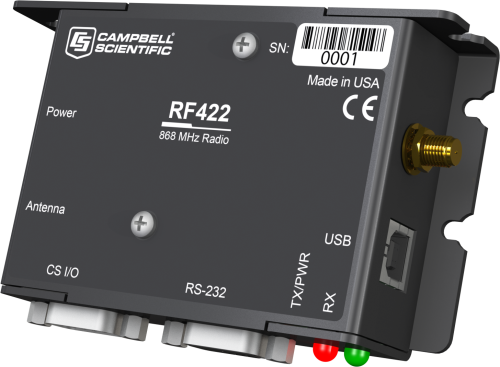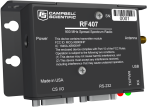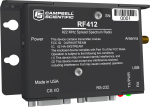
Overview
The RF422 is an 868 MHz SRD860 radio designed to provide license-free operation for wireless serial communications in Europe. The RF422 transmits data at 10 kbps with a maximum power of 25 mW, and it employs listen-before-talk (LBT) and adaptive-frequency-agility (AFA) to provide a robust link of up to 5 km (line-of-sight). The RF422 supports point-to-point and point-to-multipoint data logger communications and PakBus repeater operation.
The RF422 is part of the RF407 series of radios that includes:
- RF407: North America (FCC & IC), 902 to 928 MHz
- RF412: Australia (ACMA RCM), 915 to 928 MHz
- RF422: Most of Europe and some of Asia (ETSI), 863 to 870 MHz
- RF427: Brazil (ANATEL), 905/920 MHz
Benefits and Features
- Does not require individual operational license in Europe
- Robust serial communication, optimized for PakBus networks
- Low power (< 2 mA idle) during periods of inactivity
- Supports point-to-point with RF retries and point-to-multipoint operations
- Remote diagnostics using PakBus node operations
- Operational power can be supplied over USB when attached to PC
Images








Detailed Description
System Components
An RF422 radio needs to be at both the base station and field site. Each radio requires an antenna that does not exceed 2.1 dBi in gain over the 863 to 870 MHz frequency range, such as the 28767 whip antenna offered by Campbell Scientific.The RF422 has a reverse polarity SMA (RPSMA) connector for attaching the antenna or antenna cable.
Powering the Radio
At the base station, the radio typically uses ac power that is either supplied by the 15966 wall charger or through the PC via the USB port and cable. At the field site, the radio is typically powered by the data logger through the CS I/O port. The 14291 Field Cable can also be used to connect the radio to an appropriate 12 Vdc power supply. This field cable is required when the radio is connected to the data logger’s RS-232 port instead of the CS I/O port.
Compatibility
The RF422 is over-the-air compatible with other RF422-based products. The RF422 can only communicate wirelessly with other RF422 radios and other Campbell Scientific products that have the "-RF422" option.
Data Logger Considerations
The RF422 attempts to optimize communications for PakBus-capable devices. However, it will also automatically operate in a transparent, broadcast serial mode when PakBus is not detected. The RF422 is compatible with all Campbell Scientific data loggers. When the RF422 is connected to a data logger's DB9 RS-232 port, a 18663 null modem cable will likely be needed. When the RF422 is connected to a data logger's CS I/O port, use the supplied SC12 cable. For legacy "mixed array" data loggers (such as the CR10), you can use an SC932A or SC105 to connect the data logger's CS I/O port to the RF422's RS-232 port.
Specifications
| Radio Type | SRD860, LBT+AFA |
| Restrictions | See REC70-03E, CEPT recommendation on the use of SRD. |
| Compliance | Listen before talk (LBT) and automatic frequency agility (AFA) to comply with ETSI duty cycle requirements. Radio communication effective duty cycle = (number of channels * 100) / 3600. |
| Channel Capacity | 30 channels (default), software configurable for the purpose of meeting local regulations; 10 sequences for reducing interference through channel hop. |
| Frequency | 863 to 870 MHz |
| Country Used In | UK and EU |
| Transmission Distance |
|
| Power Output | 2 to 25 mW (software-selectable; assuming 2 dBi antenna gain) |
| Maximum Nodes in Network | 20 |
| Receiver Sensitivity | -106 dBm |
| RF Data Rate | 10 kbps |
| Link Throughput | 8 kbps |
| Antenna Connector | Reverse Polarity SMA (RPSMA) jack |
| LEDs | Red TX/PWR and green RX |
| RS-232 Baud Rate | 1200 to 115200 bps |
| CS I/O Modes | SDC 7, 8, 10, 11, and ME master |
| Power | 9 to 16 Vdc |
| Power Connector | 2.5 mm dc power jack |
| Operating Temperature Range | -40° to +70°C |
| Regulatory Approvals | ETSI CE/RED, RoHS compliant |
| Average Current Drain |
|
| Communication Ports |
|
| Service Requirements | Shares frequency with other devices. Must not cause harmful interference to licensed radios. Requires line-of-sight. |
| Dimensions |
11.1 x 6.9 x 2.7 cm (4.4 x 2.7 x 1.1 in.) Dimensions are from the tip of the antenna connector to the other side of the case, and from the bottom of the case to the top of the DB9 connector jack screw. The width includes the thickness of the screw heads on the screws that hold the case together. |
| Weight |
|
LBT+AFA Performance |
|
| Channel Spacing | 100 kHz |
| Receiver Bandwidth | 150 kHz |
| Modulation Bandwidth | < 300 kHz |
| LBT Threshold | < -88 dBm |
| TX on Time | < 1 s |




